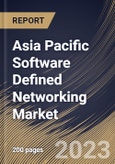Automation is a key driver in the SDN market, as organizations seek to streamline network management tasks and reduce manual interventions. SDN enables programmability, allowing for automated configuration and management of network resources. This improves operational efficiency and minimizes the risk of human errors. SDN will enable organizations to optimize their network infrastructure by dynamically allocating resources based on real-time requirements. This results in improved resource utilization, reduced latency, and enhanced network performance. As businesses strive for efficiency and cost-effectiveness, SDN presents an attractive solution for network optimization.
SDN plays a crucial role in data center networking by furnishing a centralized and programmable approach to managing network resources. This mainly benefits large-scale data centers where agility and scalability are paramount. SDN allows administrators to allocate resources dynamically and efficiently, improving data center performance. SDN extends its benefits to wide-area networking, enabling organizations to create more responsive and adaptable networks across geographically dispersed locations. This primarily benefits businesses with multiple branches or a regional presence, as SDN facilitates centralized control and orchestration of WAN resources.
Several nations in the Asia Pacific region are actively pursuing digital transformation initiatives across industries. Many cities in the Asia Pacific are transforming smart cities. Industries in the Asia Pacific are adopting Industry 4.0 principles, integrating digital technologies into manufacturing processes. The four Japanese mobile carriers will accrue a collective capital expenditure of over $14 billion to construct their 5G networks, according to a report updated by the International Trade Administration in 2020. Automation improves efficiency, reduces manual intervention, and enables rapid configuration changes, aligning with the dynamic nature of modern telecommunications networks.
The China market dominated the Asia Pacific Software Defined Networking Market by Country in 2022 and would continue to be a dominant market till 2030; thereby, achieving a market value of $5,366 million by 2030. The Japan market is registering a CAGR of 17.3% during (2023 - 2030). Additionally, The India market would showcase a CAGR of 18.8% during (2023 - 2030).
Based on Offering, the market is segmented into Software, SDN Infrastructure and Services. Based on Type, the market is segmented into Open SDN, SDN via Overlay, SDN via API, and Hybrid SDN. Based on Application, the market is segmented into SD-WAN, SD-LAN, Security Applications, and Others. Based on End-User, the market is segmented into Enterprises, Telecommunication Service Providers, and Cloud Service Providers. Based on Vertical, the market is segmented into BFSI, Government & Defense, Education, Healthcare & Lifesciences, Media & Entertainment, Manufacturing, Retail & eCommerce, ITeS and Others. Based on countries, the market is segmented into China, Japan, India, South Korea, Singapore, Malaysia, and Rest of Asia Pacific.
The market research report covers the analysis of key stake holders of the market. Key companies profiled in the report include Cisco Systems Inc., Huawei Technologies Co., Ltd. (Huawei investment & Holding Co., Ltd.), VMware, Inc. (Broadcom Inc.), Dell Technologies, Inc. (Dell EMC), Juniper Networks, Inc., IBM Corporation, Ericsson AB, Ciena Corporation, Hewlett Packard enterprise Company and Nokia Corporation.
Scope of the Study
Market Segments Covered in the Report:
By Offering
- Software
- SDN Infrastructure
- Services
By Type
- Open SDN
- SDN via Overlay
- SDN via API
- Hybrid SDN
By Application
- SD-WAN
- SD-LAN
- Security Applications
- Others
By End-user
- Enterprises
- Telecommunication Service Providers
- Cloud Service Providers
By Vertical
- BFSI
- Government & Defense
- Education
- Healthcare & Lifesciences
- Media & Entertainment
- Manufacturing
- Retail & eCommerce
- ITeS
- Others
By Country
- China
- Japan
- India
- South Korea
- Singapore
- Malaysia
- Rest of Asia Pacific
Key Market Players
List of Companies Profiled in the Report:
- Cisco Systems Inc.
- Huawei Technologies Co., Ltd. (Huawei investment & Holding Co., Ltd.)
- VMware, Inc. (Broadcom Inc.)
- Dell Technologies, Inc. (Dell EMC)
- Juniper Networks, Inc.
- IBM Corporation
- Ericsson AB
- Ciena Corporation
- Hewlett Packard enterprise Company
- Nokia Corporation
Unique Offerings
- Exhaustive coverage
- The highest number of Market tables and figures
- Subscription-based model available
- Guaranteed best price
- Assured post sales research support with 10% customization free
Table of Contents
Companies Mentioned
- Cisco Systems Inc.
- Huawei Technologies Co., Ltd. (Huawei investment & Holding Co., Ltd.)
- VMware, Inc. (Broadcom Inc.)
- Dell Technologies, Inc. (Dell EMC)
- Juniper Networks, Inc.
- IBM Corporation
- Ericsson AB
- Ciena Corporation
- Hewlett Packard enterprise Company
- Nokia Corporation








